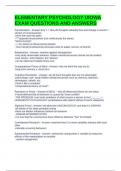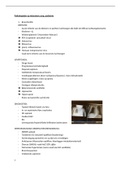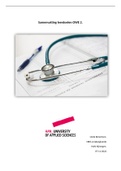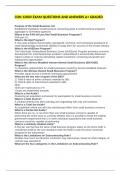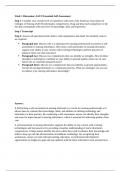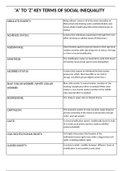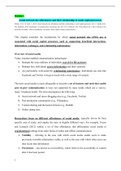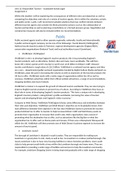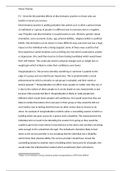ELEMENTARY PSYCHOLOGY UIOWA
EXAM QUESTIONS AND ANSWERS
Functionalism - Answer-Key ? = How do thoughts naturally flow and change w enviro?...
stream of consciousness
-more than just tiny parts
-****opposed structuralism (not continuously the same)
*WON IN END*
---> by James & influenced by Darwin;
- how mental & behavioral processes work to adapt, survive, & flourish
Behaviorism - Answer--reaction against introspection
-only study observable behavior; hidden mental processes should not be studied
-Ivan Pavlov, John Watson, B.F Skinner
-can be observed multiple times over
Computational Theory of Mind - Answer--why we think the way we do
-long-term memory v. short term
Cognitive Revolution - Answer--we all have thoughts that are not observable
-psychology *can* study hidden mental processes such as memory, attention,
stereotypes, beliefs, etc.
-mind is like a computer
*computational theory of mind*``
Reactions to Freud - Answer-(1950's) -- this all influenced where we are today
-Freud believed that all behavior is caused by *inner conflict*
-THE PROBLEM: over looks problems of what causes a person to feel _______ =
HUMANISTIC PSYCHOLOGY (emphasizes with patient without Freud's viewpoint)
Sigmund Freud - Answer-*all about the UNCONSCIOUS* and that it is DARKKK
-all details of his ideas probably wrong
-there are hidden influences behind our behavior
- DREAM INTERPRETATION
-it is true that the unconscious does influence behavior *but* it's limited!
Correlational Research - Answer--examine how 2 or more variables interact with each
other
-naturally occurring behaviors
Experimental Research - Answer--researcher manipulates 1 variable & measures
effects of the manipulation on another
- random assignment
,3rd variable - Answer--will effect both; Z (third variable) will effect both X & Y
Theory - Answer--supported by an operational definition
---> FROM THE BOOK: an explanation using an integrated see of principles that
organizes observations and predicts behaviors or events
Operational Definition - Answer--a way to measure what you want to measure
---> FROM THE BOOK: a carefully worded statement of the exact
procedures/operations used in a research study [IE: human intelligence may be
operationally defined as what an intelligence test measures
Hypothesis - Answer--statement/prediction we can systematically test
--->FROM THE BOOK: a testable prediction, often implied by a theory
Independent Variables (IV) - Answer--manipulated by expire expirementor (control v.
experimental group)
--->FROM THE BOOK: in an experiment, the factor that is manipulated; the variable
whose effect is being studied
Dependent Variables (DV) - Answer--measured
---> FROM THE BOOK: in an experiment, the outcome that is measured; the variable
that may change when the independent variable is manipulated
Confederate - Answer-a person who is given a role to play in a study so that the social
context can be manipulated
external validity - Answer-the extent to which the results of a study can be generalized
to other situations and to other people REAL WORLD ISSUES
internal validity - Answer-extent to which we can draw cause-and-effect inferences from
a study
Bias - Answer--systematically affects participant performance
Demand Characteristics - Answer--cues that reveal what the experimenters
expectations of the participants are to them
Placebo Effects - Answer--reason fro double-line studies [neither the participants nor
those who administer the drug or placebo and collect the data will know which group is
receiving treatment]
---> FROM THE BOOK: experimental results caused by expectations alone; any effect
on behavior caused by the administration of an inert substance or condition, which the
recipient issues is an active agent {well documented in reducing pain, depression, and
anxiety}
Psychokinesis - Answer--the ability to affect physical objects with the mind
,Psi Phenomena - Answer--a broad term for both extrasensory perception (ESP) &
psychokinesis, the ability to affect physical objects with the mind
-Why is this not justifiable?
---> it does not replicate (not verifiable)
---> no structure
ESP or Extrasensory Perception - Answer-- 6th sense
the controversial claim that perception can occur apart from sensory input; includes
telepathy, clairvoyance, and precognition
Characteristics of Science - Answer-(1) Structured Empiricism (empiricism =
observation)
(2) Verification: peer review (replication= likely to be VALID results)
(3)testable hypothesis
Cautionary Points {guidelines for critical thinking} - Answer-1. Anecdotes do not make a
Science
2. Bold claims aren't necessarily true
3. Just because something is unexplained doesn't mean that an explanation doesn't
exist
4. Coincidence ("synchronicity")
5. Don't appeal to authority only
6. explore alternative explanations
Einstein's Brain - Answer--parietal lobe used for location making
Thomas Hardy - Answer--he fixed & sectioned Einstein's brains so he could study it
after getting consent from his family [Einstein originally asked for this not to occur]
-brain missing for 2 decades
-gave tissue samples to labs & some studies show what makes us smart like Einstein.
What are the 3 main divisions of the brain? - Answer-1.) hindbrain
2.) midbrain
3.) forebrain
Hindbrain - Answer--lowest set of structures in the brain
-Vecera says: think of it as your reptilian brain because many of the structures do the
same thing in humans that they do in reptiles
Houses:
1. Medulla
2. cerebellum
3. pons
Medulla - Answer-beings where spine enters skull
- breathe, HR, reflexes
, Cerebellum - Answer-A large structure of the hindbrain that controls fine motor skills.
Pons - Answer-A brain structure that relays information from the cerebellum to the rest
of the brain - brain stem
--- sleep and arousal
brain stem - Answer-Connection to spinal cord.
--- all of hindbrain except cerebellum
Filters information flow between peripheral nervous system and the rest of the brain.
- alertness, HR, BP, breath, basics
Midbrain - Answer-- information from brain, eyes, ears
1. reticular formation
-----"sterotype behaivor patterns" turning to noise, sleeping at night
2. system using neurons and neurotransmitters
-our bird and amphibian brain because its similar in humans and amphibians
Forebrain - Answer-Largest region of brain
1. limbic system
2. thalamus
3. basal ganglia
4. hypothalamus
5. cerebral cortex
Thalamus - Answer-- the brain's sensory switchboard,
- located on top of the brainstem
- RELAY STATION - directs messages to the sensory receiving areas in the cortex and
transmits replies to the cerebellum and medulla
Basal Ganglia - Answer-- clusters of ganglia (neurons) working with cerebral cortex to
control/ coordinate normal movements (FINE/small MOVEMENTs like texting)
--> parkinson's disease, degenerative disease; resting TREMORS;
movement =stooped; hard time initiating / executing voluntary movement [can be
genetic or caused from trauma to the head]
Limbic System - Answer-located below both the left & right cerebral hemispheres;
associated with emotions and drives
contains:
---amygdala (almond shape on each side of brain...survival; what is edible, intense
emotional awareness),
----hippocampus (determines which parts of the memory should be stored/printed)
EXAM QUESTIONS AND ANSWERS
Functionalism - Answer-Key ? = How do thoughts naturally flow and change w enviro?...
stream of consciousness
-more than just tiny parts
-****opposed structuralism (not continuously the same)
*WON IN END*
---> by James & influenced by Darwin;
- how mental & behavioral processes work to adapt, survive, & flourish
Behaviorism - Answer--reaction against introspection
-only study observable behavior; hidden mental processes should not be studied
-Ivan Pavlov, John Watson, B.F Skinner
-can be observed multiple times over
Computational Theory of Mind - Answer--why we think the way we do
-long-term memory v. short term
Cognitive Revolution - Answer--we all have thoughts that are not observable
-psychology *can* study hidden mental processes such as memory, attention,
stereotypes, beliefs, etc.
-mind is like a computer
*computational theory of mind*``
Reactions to Freud - Answer-(1950's) -- this all influenced where we are today
-Freud believed that all behavior is caused by *inner conflict*
-THE PROBLEM: over looks problems of what causes a person to feel _______ =
HUMANISTIC PSYCHOLOGY (emphasizes with patient without Freud's viewpoint)
Sigmund Freud - Answer-*all about the UNCONSCIOUS* and that it is DARKKK
-all details of his ideas probably wrong
-there are hidden influences behind our behavior
- DREAM INTERPRETATION
-it is true that the unconscious does influence behavior *but* it's limited!
Correlational Research - Answer--examine how 2 or more variables interact with each
other
-naturally occurring behaviors
Experimental Research - Answer--researcher manipulates 1 variable & measures
effects of the manipulation on another
- random assignment
,3rd variable - Answer--will effect both; Z (third variable) will effect both X & Y
Theory - Answer--supported by an operational definition
---> FROM THE BOOK: an explanation using an integrated see of principles that
organizes observations and predicts behaviors or events
Operational Definition - Answer--a way to measure what you want to measure
---> FROM THE BOOK: a carefully worded statement of the exact
procedures/operations used in a research study [IE: human intelligence may be
operationally defined as what an intelligence test measures
Hypothesis - Answer--statement/prediction we can systematically test
--->FROM THE BOOK: a testable prediction, often implied by a theory
Independent Variables (IV) - Answer--manipulated by expire expirementor (control v.
experimental group)
--->FROM THE BOOK: in an experiment, the factor that is manipulated; the variable
whose effect is being studied
Dependent Variables (DV) - Answer--measured
---> FROM THE BOOK: in an experiment, the outcome that is measured; the variable
that may change when the independent variable is manipulated
Confederate - Answer-a person who is given a role to play in a study so that the social
context can be manipulated
external validity - Answer-the extent to which the results of a study can be generalized
to other situations and to other people REAL WORLD ISSUES
internal validity - Answer-extent to which we can draw cause-and-effect inferences from
a study
Bias - Answer--systematically affects participant performance
Demand Characteristics - Answer--cues that reveal what the experimenters
expectations of the participants are to them
Placebo Effects - Answer--reason fro double-line studies [neither the participants nor
those who administer the drug or placebo and collect the data will know which group is
receiving treatment]
---> FROM THE BOOK: experimental results caused by expectations alone; any effect
on behavior caused by the administration of an inert substance or condition, which the
recipient issues is an active agent {well documented in reducing pain, depression, and
anxiety}
Psychokinesis - Answer--the ability to affect physical objects with the mind
,Psi Phenomena - Answer--a broad term for both extrasensory perception (ESP) &
psychokinesis, the ability to affect physical objects with the mind
-Why is this not justifiable?
---> it does not replicate (not verifiable)
---> no structure
ESP or Extrasensory Perception - Answer-- 6th sense
the controversial claim that perception can occur apart from sensory input; includes
telepathy, clairvoyance, and precognition
Characteristics of Science - Answer-(1) Structured Empiricism (empiricism =
observation)
(2) Verification: peer review (replication= likely to be VALID results)
(3)testable hypothesis
Cautionary Points {guidelines for critical thinking} - Answer-1. Anecdotes do not make a
Science
2. Bold claims aren't necessarily true
3. Just because something is unexplained doesn't mean that an explanation doesn't
exist
4. Coincidence ("synchronicity")
5. Don't appeal to authority only
6. explore alternative explanations
Einstein's Brain - Answer--parietal lobe used for location making
Thomas Hardy - Answer--he fixed & sectioned Einstein's brains so he could study it
after getting consent from his family [Einstein originally asked for this not to occur]
-brain missing for 2 decades
-gave tissue samples to labs & some studies show what makes us smart like Einstein.
What are the 3 main divisions of the brain? - Answer-1.) hindbrain
2.) midbrain
3.) forebrain
Hindbrain - Answer--lowest set of structures in the brain
-Vecera says: think of it as your reptilian brain because many of the structures do the
same thing in humans that they do in reptiles
Houses:
1. Medulla
2. cerebellum
3. pons
Medulla - Answer-beings where spine enters skull
- breathe, HR, reflexes
, Cerebellum - Answer-A large structure of the hindbrain that controls fine motor skills.
Pons - Answer-A brain structure that relays information from the cerebellum to the rest
of the brain - brain stem
--- sleep and arousal
brain stem - Answer-Connection to spinal cord.
--- all of hindbrain except cerebellum
Filters information flow between peripheral nervous system and the rest of the brain.
- alertness, HR, BP, breath, basics
Midbrain - Answer-- information from brain, eyes, ears
1. reticular formation
-----"sterotype behaivor patterns" turning to noise, sleeping at night
2. system using neurons and neurotransmitters
-our bird and amphibian brain because its similar in humans and amphibians
Forebrain - Answer-Largest region of brain
1. limbic system
2. thalamus
3. basal ganglia
4. hypothalamus
5. cerebral cortex
Thalamus - Answer-- the brain's sensory switchboard,
- located on top of the brainstem
- RELAY STATION - directs messages to the sensory receiving areas in the cortex and
transmits replies to the cerebellum and medulla
Basal Ganglia - Answer-- clusters of ganglia (neurons) working with cerebral cortex to
control/ coordinate normal movements (FINE/small MOVEMENTs like texting)
--> parkinson's disease, degenerative disease; resting TREMORS;
movement =stooped; hard time initiating / executing voluntary movement [can be
genetic or caused from trauma to the head]
Limbic System - Answer-located below both the left & right cerebral hemispheres;
associated with emotions and drives
contains:
---amygdala (almond shape on each side of brain...survival; what is edible, intense
emotional awareness),
----hippocampus (determines which parts of the memory should be stored/printed)

